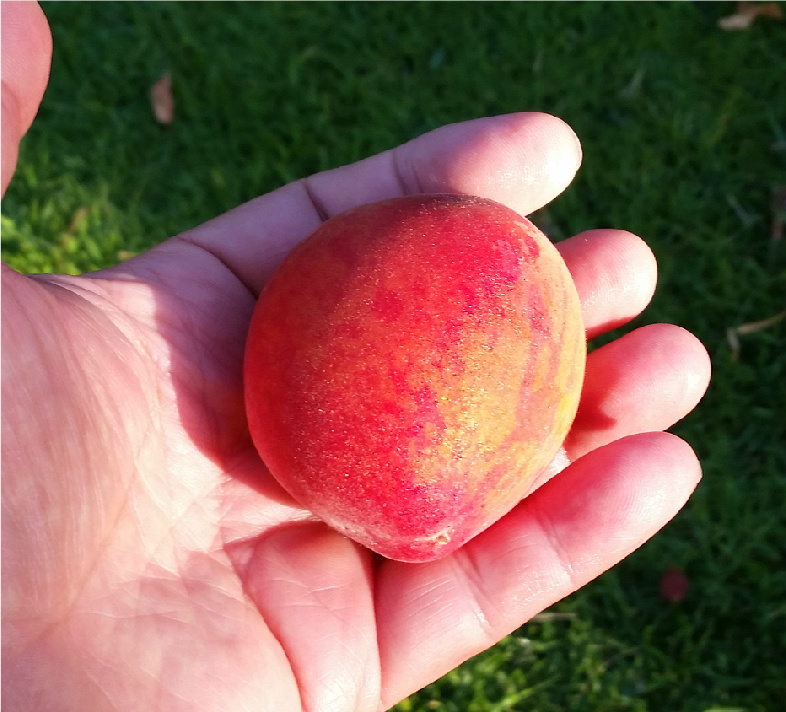‘Desert Gold’ coming in sweet, tart and juicy.
I am sooo jealous, My peach has not finished bloom yet, but you already have beautiful peach harvested yum:
Beautiful Mr. Clint. I can taste it right now! Yummmm! 
Ah, a wonderful reward for all your TLC.
Do you ever measure brix of fruit or tree sap? Arden Anderson believes that the brix of a plant indicates its ability to resist disease. So I dusted off my refractometer from when I did Reams testing and plan to test his assertions. So just curious.
DWN gives a short and incomplete explanation of plant brix which is understandable for what they do - they sell trees. Brix comes from the soil.
Brix levels are also synonymous with nutritional levels (my interest). That is, the higher the brix, the higher the nutrient density AND disease resistance.
For those interested in growing nutrient dense and disease resistant trees & veggies I refer to those documents. The disease resistance chart is the 4th one down in the 2nd reference.
Yes DWN sells trees, bushes and vines, but they also educate the home grower about methods optimally suited to that niche market. I wouldn’t be typing this right now if it weren’t for their BYOC and successive ripening techniques and easy to follow instructions. My experience has been that they know what they are talking about, and stand behind their recommendations.
I’m not going to do, “battle of the endless and conflicting links” about brix. There are true believers and they are welcome to their beliefs. I’ve got peaches, blueberries, strawbs, lemons and Bababerries to bring in. 
EDIT: I left out tomatoes, peppers, Swiss chard, kale, and herbs all coming in nicely as well. Between square foot gardening, EarthBoxes and BYOC, I’m fully engaged at the moment. 
Anne:
This is the heading on table 4:
This chart has extensions to show certain brix levels conferring plant immunity from insect, bacterial, fungal, or viral attack. The theory (field-proven time and again) is that healthy plants are almost always spared pest attack.
I can tell you from long experience that high brix doesn’t confer immunity to plant disease. In fact under high disease pressure it can be impossible to attain high brix. This is based on 20 yrs working with sugarbeets in TX. During the last 15 yrs I worked with a plant pathologist working exclusively on diseases of sugarbeet. The issue was soil borne fungal and virus diseases. Every time sugarbeets were grown on the same land sugar yield deceased by 15-20%. After about 4 crops even on a 5 yr rotation it wasn’t possible to make money growing sugarbeet. My highest sugar levels were always the first time growing beets on new land. From there it was all downhill. Growing varieties with higher sugar percentage didn’t help. They were affected just as much.
Bottom line, with high disease pressure it was impossible to attain high brix. The diseases were in control not the brix level. In the end the sugarbeet industry in Texas went belly up in 1992 primarily due to this issue.
Whoa. Hey. That’s where I began too. I’m not at all knocking them. Perhaps I described them to tersely. My intention was to explain their description of brix in terms of what they do - and do very well.
My intention also, and maybe that of others, is to improve nute density in the end product, AND, perhaps, as an added benefit need less disease/insect intervention. This is more about the soil than the tree.
Thank you, Steven for sharing your experience.
High brix is not what confers immunity directly. It is the soil ingredients/and balance thereof that creates the high brix, that also creates the immunity. So both come from the soil, not each other.
So did you do Reams testing on those fields to see what remediants were needed?[quote=“fruitnut, post:8, topic:5625”]
Bottom line, with high disease pressure it was impossible to attain high brix.
[/quote]
But Steven, is it plausible that a plant that is unable to access or uptake nutes could not support its own disease resistance? Just like humans?
We did hundreds of soil tests each yr. We usually sampled by one ft increments to 6ft depth.
I find the whole supposition both for plants and people too simplistic. Does nutrition or wellness protect from AIDS? I don’t think so. And I’m a lifelong supporter of wellness.
You are welcome to your opinion. And I don’t wish to debate the subject. Let MrClint have his topic back.
Carry on and don’t mind me. I’ll probably just start another topic on nectarines that are starting to come in (a bit ahead of schedule) as well. 
